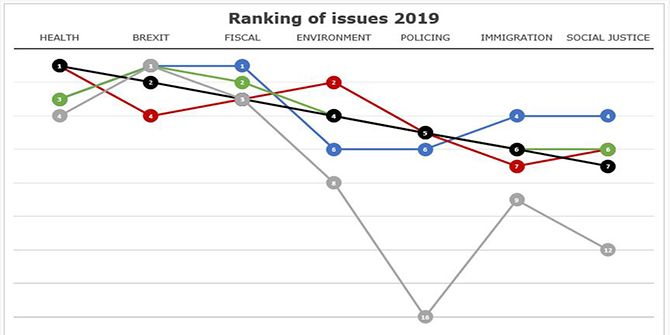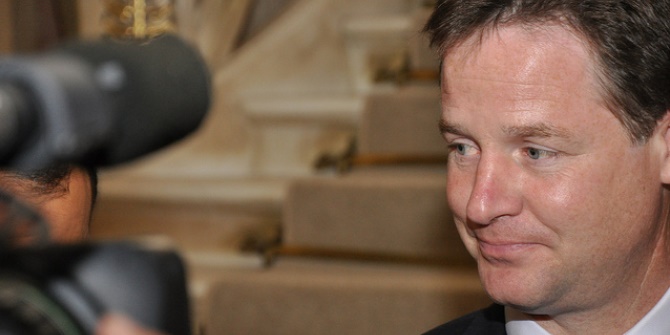Tactical voters are a staple of every UK election in recent decades and they can play a pivotal role in election outcomes. Lucas Núñez shows that parties’ campaigning efforts influence the extent of tactical voting, both encouraging loyalty to and defection from weaker parties in a constituency. If Conservatives want to minimize their losses in the upcoming election, they should pay more attention to tactical voters than before.
 In the run-up to an election, political parties deploy their strategies to convince voters to turn out and vote for them. They do so in a variety of ways: from mass appeals through the national media, leader speeches and events, as well as contacting voters directly in a variety of ways: canvasing, mailers, leaflets, and social media, among others. Typically, parties have two interrelated goals: turnout and persuasion. Get out the vote efforts are designed to encourage those who already support the party to actually turn out and vote. Persuasion efforts, on the other hand, aim at persuading or converting voters who may initially prefer another party or who are somewhat on the fence. Persuasion requires parties or candidates convincing the voters that their policy ideas or personal qualities are better.
In the run-up to an election, political parties deploy their strategies to convince voters to turn out and vote for them. They do so in a variety of ways: from mass appeals through the national media, leader speeches and events, as well as contacting voters directly in a variety of ways: canvasing, mailers, leaflets, and social media, among others. Typically, parties have two interrelated goals: turnout and persuasion. Get out the vote efforts are designed to encourage those who already support the party to actually turn out and vote. Persuasion efforts, on the other hand, aim at persuading or converting voters who may initially prefer another party or who are somewhat on the fence. Persuasion requires parties or candidates convincing the voters that their policy ideas or personal qualities are better.
But turnout and persuasion are not the only ways in which parties can increase their support through campaigning efforts. In multiparty elections under first past the post, like the United Kingdom, many voters have strong incentives to cast a tactical vote, that is, to vote for a party they like less than their most preferred, but with higher chances of winning and at risk of losing to a party they like even less. Campaigning efforts can also target these voters. In particular, parties with decent chances of carrying a seat can encourage defections from parties unlikely to carry it. Similar to persuasion, encouraging defections involves voters changing their choice from one party to another. Unlike persuasion, however, encouraging defections does not require the party to convince the voter their candidate is superior to their original choice; that is, to alter the voter’s sincerely held preferences. Instead, parties need only remind or encourage the voter to focus on who is likely to win (and who is not). Thus, while persuasion involves changing voters’ hearts, encouraging tactical voting defections requires only changing their minds.
When a voter is contacted by their preferred alternative party – a less liked party with higher chances of winning the seat – they become approximately 5 percentage points more likely to cast a tactical vote, thus defecting from their most preferred party.
My recent research shows that in the last three United Kingdom General Elections, tactical voting was the optimal choice for approximately one third of all voters. These were voters whose most preferred party was rather unlikely to carry the seat and had an alternative one that they preferred less but which had higher chances of winning. During the 2015 General Election, approximately one third of these voters chose to cast a tactical vote, defecting their most preferred party; whereas in the 2017 and 2019 General Elections approximately half of them did. But to what extent do parties’ campaigns encourage defections in the form of a tactical vote, or loyalty in the form a sincere one?
Using data from the British Election Study for the 2015, 2017, and 2019 UK Elections, my research shows that parties can indeed increase their support by contacting voters who face tactical incentives, without changing the voters’ preferences. I find that when a voter is contacted by their preferred alternative party – a less liked party with higher chances of winning the seat – they become approximately 5 percentage points more likely to cast a tactical vote, thus defecting from their most preferred party. On the other hand, being contacted by their most preferred party encourages loyalty to it (even when a tactical vote is optimal) and voters become about 4 percentage points less likely to cast a tactical vote.
While parties’ outreach efforts have a modest impact on tactical voting, they can play an important role in constituencies that are closely contested.
Contact by a voter’s preferred alternative party is more effective at encouraging defection than contact by the most preferred party is at encouraging loyalty. But additionally, those alternative parties typically conduct campaigns of higher intensity in the relevant constituencies, given their higher chances of winning the seat. Put together, this means that preferred alternative parties tend to have an advantage in encouraging defections from a most preferred party and thus a tactical vote. Overall, I find that parties’ direct voter outreach efforts are responsible for about a 2 percentage points increase in tactical voting nationwide.
While parties’ outreach efforts have a modest impact on tactical voting, they can play an important role in constituencies that are closely contested. The upcoming 2024 General Election in July is no exception. Based on YouGov’s MRP projections, there are 146 seats in which the margin of victory falls below 5 percentage points – about one fifth of all seats in Parliament. Of those, 128 are currently held by a Conservative MP. In all of those seats there are sufficient voters for the third and lower ranked parties for tactical voting to sway the election one way or the other. Thus, especially for the Conservatives, who are expected to face large losses in Parliament, ensuring they encourage defections from voters who view them as their alternative party can go a long way in minimizing their projected loses. In most instances, this means encouraging tactical defections from voters who prefer Reform UK instead.
If Conservatives wish to minimize their losses in the July election, giving more attention than usual to tactical voters may help them do so, especially by targeting those who may prefer Reform UK.
But how can parties encourage tactical voting? By simply reminding voters of the tactical voting opportunities in their constituencies. In fact, candidates in the United Kingdom sometimes highlight the tactical situation in their constituencies alongside with messages designed for turnout and persuasion. OpenElections has collected and classified data on campaign leaflets used during General Elections in the United Kingdom. In 2019, about a quarter of all leaflets mentioned the tactical situation in the constituency, a fair amount. The trouble for the Conservatives is that their candidates rarely talk about the tactical situation: only 15 percent of Conservative leaflets did so in 2019. If Conservatives wish to minimize their losses in the July election, giving more attention than usual to tactical voters may help them do so, especially by targeting those who may prefer Reform UK. Naturally, their main competitor in any one constituency can rely on the same strategy and to the same effect. But any candidate with a chance of carrying a seat who disregards potential tactical voters is conceding ground to their opponents.
All articles posted on this blog give the views of the author(s), and not the position of LSE British Politics and Policy, nor of the London School of Economics and Political Science.
Image credit: WD Stock Photos on Shutterstock







